Fields of Activity
The experts at AZT deal with different questions in the field of automotive technology. Their fields of activity cover both conventional vehicle-related issues and innovations in the automotive area.
Road safety
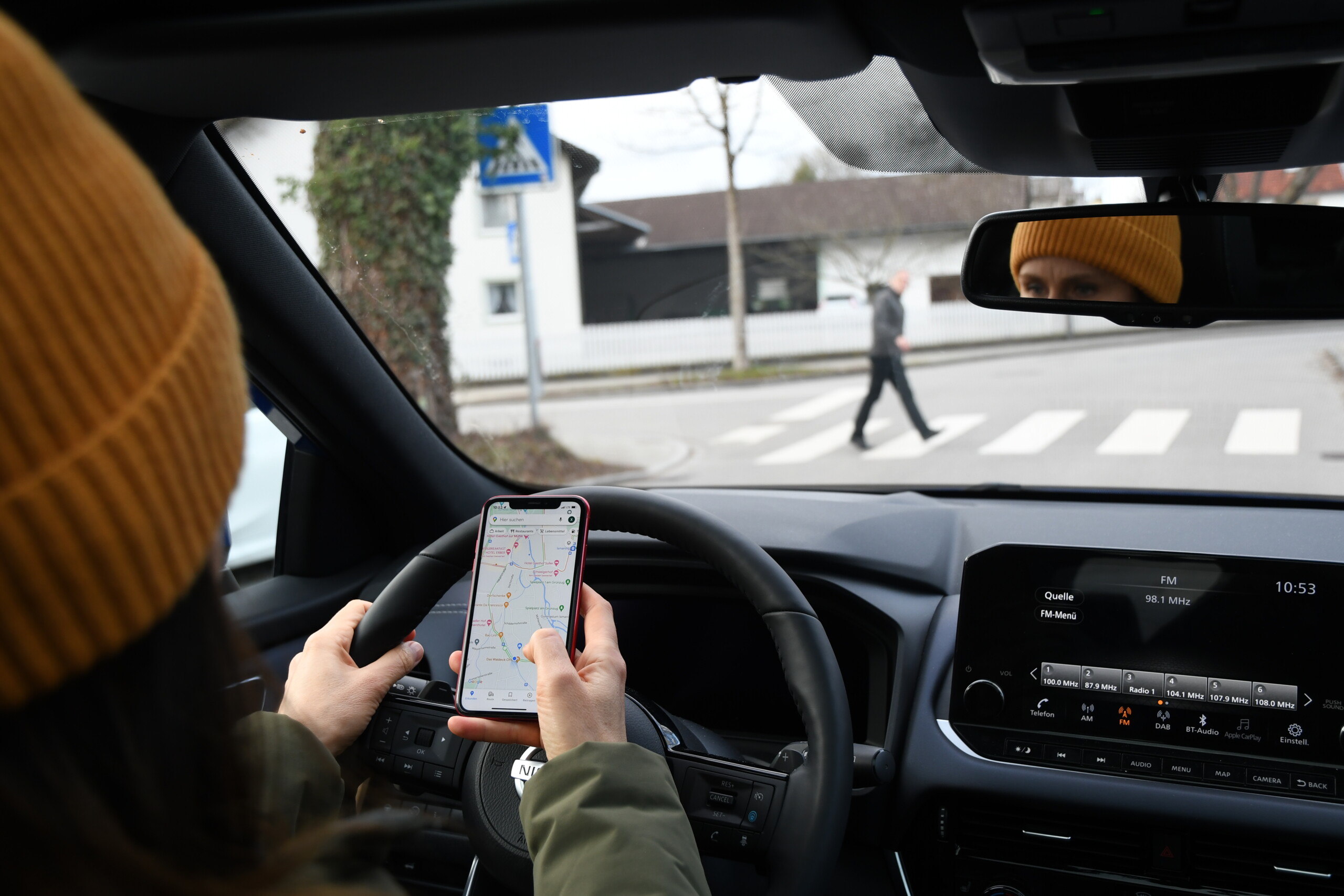
According to the statistics of the World Health Organization (WHO), every year more than 1.35 million people across the world die in road traffic accidents, and up to 50 million are injured. In Germany, over 3,000 people lose their lives as a result of road-traffic accidents. The risk is high particularly for unprotected road users - pedestrians and cyclists.
Long-term road-safety research and road-safety work have always been indispensable in ensuring safe mobility on our streets and protecting people from injury. For almost 50 years now, AZT has been supporting this development via its own studies, committee work and safety campaigns. In this conjunction, the focus is, at all times, on the interaction in the human-vehicle-environment system, and safety is understood as the outcome resulting from safe people, safe vehicles and a safe environment.
To this end, accident research at AZT analyzes, in detail, vehicle damage using representative random checks from insured claims by addressing manifold questions. For example, this allows information to be gleaned on the course of events leading to an accident or the severity of injuries, and research may be conducted with regard to the frequencies of certain types of accidents or prevention potential. The investigations range from minor P&C damage to accidents resulting in extremely severe bodily injuries involving cars, trucks, motorcycles or other classes of vehicle. With the aid of collision tests, analytical case studies on accidents, survey studies and statistical evaluations, the safety research conducted at AZT sheds light on biomechanical problems, the interaction between humans and machines as well as on the conduct of road users. The focus here lies on groups who are especially at risk, such as senior citizens and young drivers, and on the risk behavior displayed by car drivers as in the case of distractions for example.
Topics are, amongst others:
- accidents involving trucks and goods vehicles
- large losses involving cars
- accidents involving agricultural vehicles
Die Sicherheitsforschung im AZT beleuchtet in Aufprallversuchen, unfallanalytischen Fallarbeiten, Befragungsstudien und statistischen Auswertungen Probleme der Biomechanik, der Mensch-Maschine-Interaktion und des Verhaltens der Verkehrsteilnehmer. Im Fokus stehen hier besonders gefährdete Gruppen wie Senioren oder junge Fahrer und das Risikoverhalten der Autofahrer wie etwa die Ablenkung.
Topics are, amongst others:
- pedestrian safety (Sicherheit zu Fuß Gehender (2019), in German language only)
- safety of cyclists and pedelec users (Sicherheit von Fahrrad- und Pedelec Fahrender (2013), in German language only)
- young drivers (Junge Fahrer und Fahrerinnen (2014), in German language only)
- bicycle helmet campaign (Video: Willi Weitzel hat's geschnallt - Fahrradfahren: Immer mit Helm!)
- senior citizens (Seniorinnen und Senioren (2009), in German language only)
- proper child safety in cars (Video: Willi Weitzel hat's geschnallt - Kindersitze)
- distractions while driving (Ablenkung durch moderne Informations- und Kommunikationstechniken (2016), in German language only)
- distraction and modern technology (Ablenkung und moderne Technik (2023), in German language only)
- the blind spot with trucks (Video: Schon gewusst? - Der tote Winkel)
External video
This video is loaded in a YouTube player. This means that Google collects information about your use of the information provided and uses it for analysis and marketing purposes. However, if you would still like to view this video, you must change the cookie settings.
Open cookie settings
"Schon Gewusst? - Der tote Winkel"
The insights gained from the AZT research on road safety are not only incorporated in measures and recommendations for damage prevention, but also serve the product development at Allianz companies in the interests of the customers. Auto liability, accident or fleet insurances may be oriented to the needs and risks of the road users. Via cross-company and international working groups and projects, results also contribute towards improved norms and standards as well as official positions and requirements put forward by safety committees and associations. Amongst others, the AZT experts also collaborate on the drafting of resolutions for adoption by the German Road Safety Council (DVR).
Accident analysis at AZT
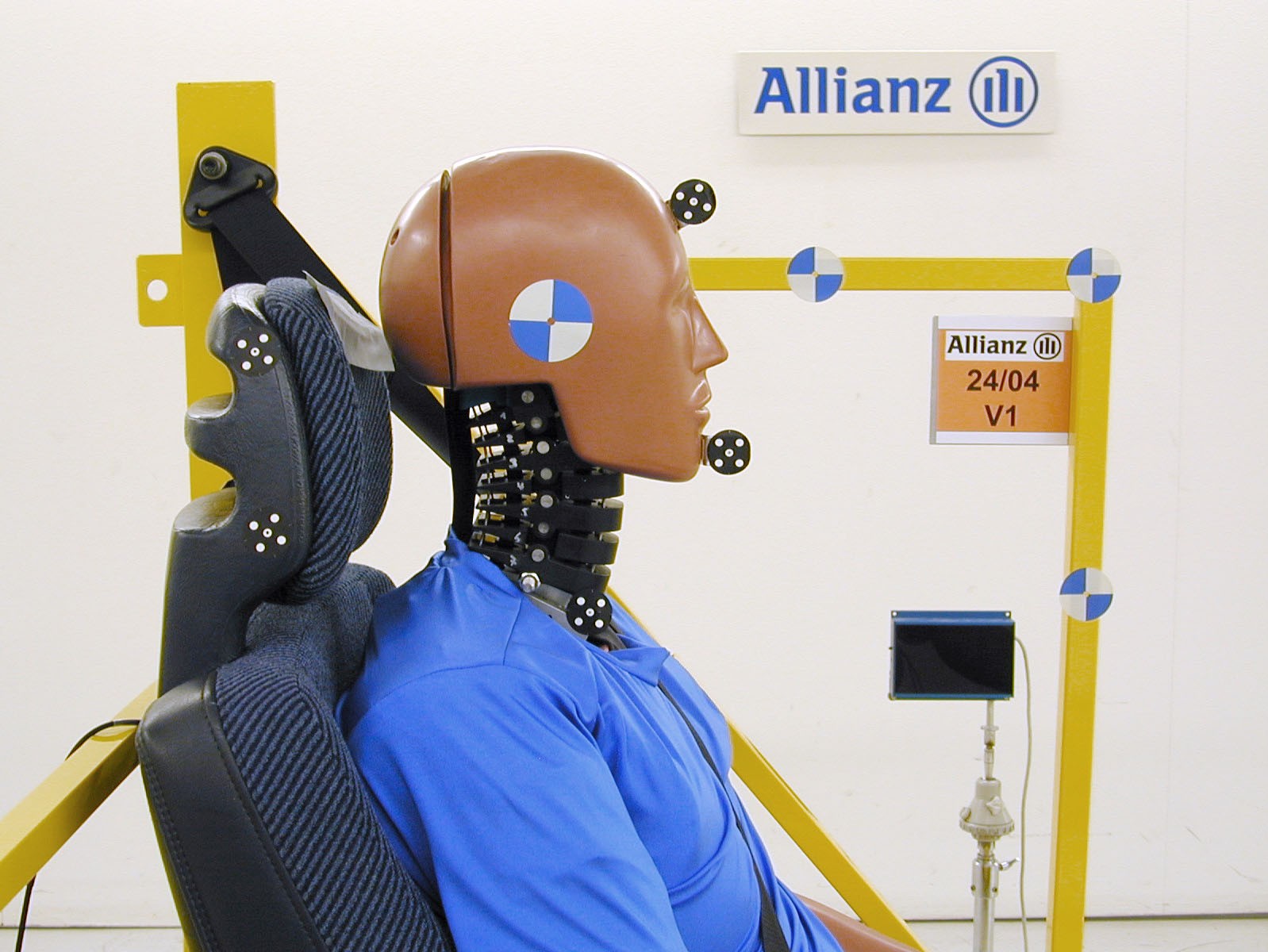
BioRid Dummy for rear impact tests
The Allianz Center for Technology supports the accident analysis, the technical non-sales staff and the mobile claims service of Allianz with accident-analysis issues with regard to occupant safety, plausibility and compatibility, as well as in respect of especially complex loss events. These loss events are reconstructed and simulated or even "retraced" in experiments using state-of-the-art software.
Moreover, studies on current issues in accident analysis, accident reconstruction and occupant safety are published on a regular basis. The insights gained from these studies are then passed on both internally and externally during workshops, training seminars for experts, congresses and conferences.
These investigations cover the following areas:
- occupant safety with focus on cervical spinal distortion
- accidents with unprotected road users
- general liability claims
- minor collisions involving cars
- cargo securing (Video)
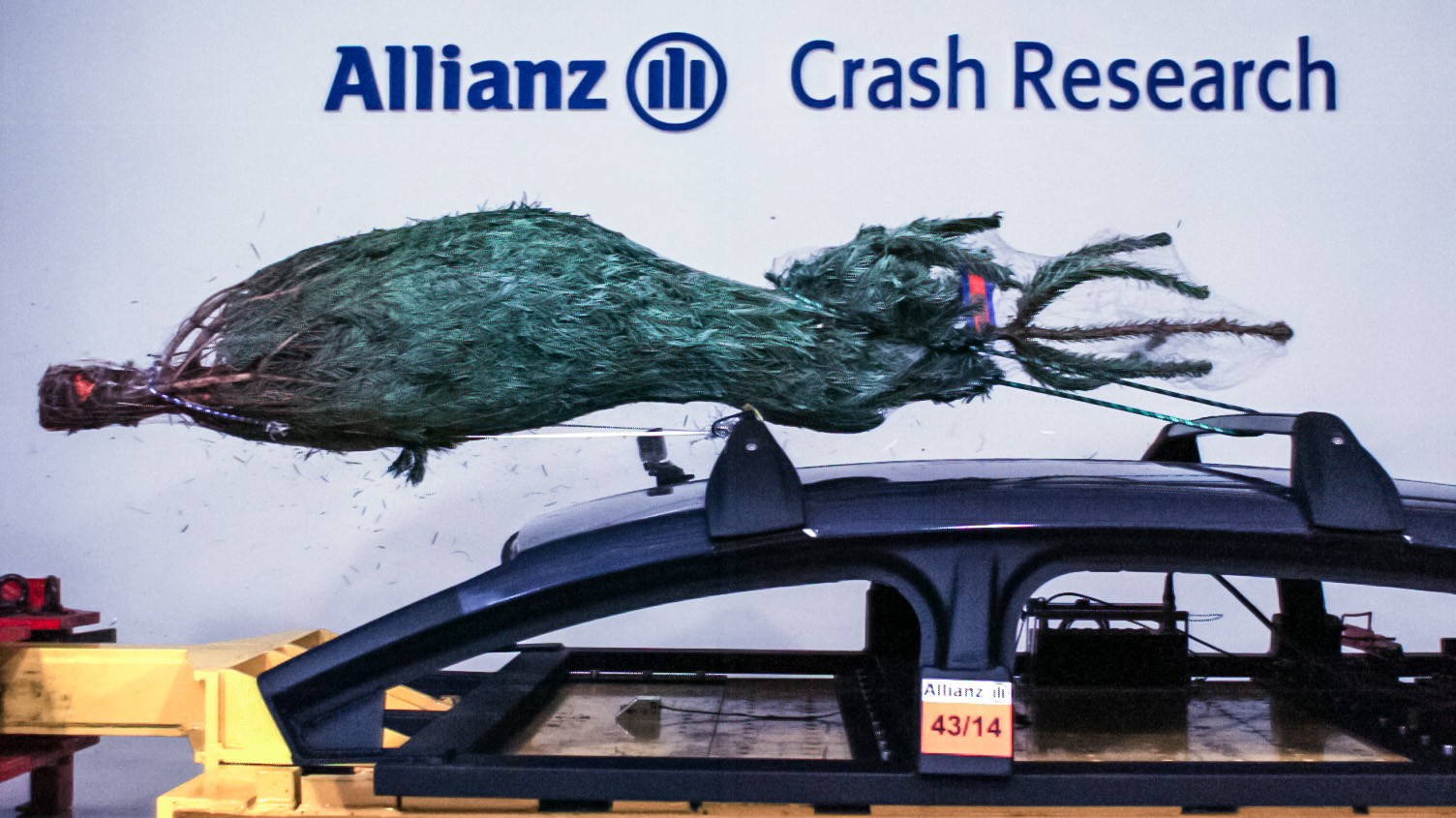
Road safety - the relevant crash tests
The Allianz Center for Technology does not only play an active role in improving repairability.
It is also dedicated to increasing road safety, for example, by providing Allianz customers with pertinent information. Do you know, for example, how to secure you dog properly? Or what could happen if you rest your feet on the dashboard? In such contexts, demonstration crashes are conducted on our own crash track in order to highlight the problems and raise awareness amongst car-drivers.
In practice, these experiments are aimed at demonstrating the forces involved in an accident and the consequences. These instructive tests are performed and published with regard to issues such as securing cargo, travelling with dogs in the car, the proper use of seatbelts and airbags, as well as fan processions and cycling.
Protect yourself and any passengers entrusted to your care!
External video
This video is loaded in a YouTube player. This means that Google collects information about your use of the information provided and uses it for analysis and marketing purposes. However, if you would still like to view this video, you must change the cookie settings.
Open cookie settings
Sustainability
Since the founding of the Allianz Centre for Technology in 1971, various aspects of sustainability have been among our central tasks. Even the fundamental ideas of the AZT, such as the promotion of repair-friendly vehicles and the contribution to greater road safety, are closely linked to the concept of sustainability. Up until the 2010s, the AZT mainly focussed on technical and social sustainability issues. With the increasing focus of regulation on sustainability, the AZT has taken up earlier approaches to quantify sustainable claims management again. In addition, strategic conceptual projects were added at the beginning of the 2020s, in which the AZT supports both Allianz Versicherungs-AG and Allianz SE as a superordinate international holding company in a wide variety of issues and projects. As the topic of sustainability continues to grow in importance and we increase our activities in this area, we have included sustainability as an explicitly named pillar in our portfolio of tasks. In doing so, we are explicitly honouring our vision of safe, sustainable and affordable mobility.
Some of our initiatives and projects in the various areas of sustainability are listed below.
Sustainability from a technical perspective
- ‘Repair’ instead of ‘renew’:
The topic of repairing damaged components instead of replacing them has always been deeply rooted in the AZT. For example, repair examples on sheet metal and plastic components are carried out at the AZT and recorded according to REFA methodology and can be subscribed to by interested parties (link to order form, available only in German language). The aim is to show what can be repaired and what effort is involved in order to help both workshops and experts with the calculation.
In addition, the AZT already analysed the ecological footprint of repair work involving the replacement of components in 2009 in cooperation with the Karlsruhe Institute of Technology (KIT) and published the project results (link to the study, available only in German language). While the response to this study was rather modest at the time and only took place within a small circle of experts, a new edition in 2023 attracted a great deal of attention. The report ‘Repair or Replace’ (see Link), which is available free of charge in the download area, impressively shows the potential savings in CO2 equivalents (CO2e) when repairing components compared to replacing them.
External video
This video is loaded in a YouTube player. This means that Google collects information about your use of the information provided and uses it for analysis and marketing purposes. However, if you would still like to view this video, you must change the cookie settings.
Open cookie settings
- Reuse of OEM spare parts / ‘used parts’:
Of course, it is not technically and/or economically possible to repair damaged components in every case of damage. In order to significantly reduce the CO2e footprint that a newly produced spare part contributes to the overall CO2e footprint of damage, the reuse of OEM spare parts is a technically and ecologically sensible option. The AZT has supported a pilot project by Allianz Versicherungs-AG and also carried out its own repair trials with reused OEM spare parts. After weighing up the solvable challenges of this repair method, which is not yet established on the German market, and the ecological benefits, Allianz Versicherungs-AG decided in 2024 to make greater use of this sustainable option as a pioneer. - Investigating new repair methods:
Just as the bodywork trade has evolved from coachbuilding to the present day, production processes and joining techniques have also continued to develop. This also offers the opportunity for new repair methods. For example, the AZT was heavily involved in the investigation of ‘gluing and riveting’ as a joining method in the repair of bodywork damage. Together with partners from industry, the possibilities and limitations of this repair method were investigated and presented to interested vehicle manufacturers. Nowadays, ‘bonding and riveting’ has become an integral part of everyday workshop life and is the joining method of choice, particularly for multi-material mix car bodies. - Repair of leisure vehicles:
Motorhomes are not comparable to cars or light commercial vehicles in terms of their structural design, although these are generally based on well-known and widely used chassis. In addition, both motorhomes and caravans are often highly customised. All of this leads to enormous complexity in the calculation of damage claims and corresponding challenges in the repair business. Together with the predecessor associations of the current Caravaning Industrie Verband e.V. (CIVD), the AZT has developed a repair manual for leisure vehicles and has supported and accompanied its further development ever since. The basis for this is, among other things, the exploration of the market for new repair options and the collection of own experience in practical execution and implementation.
Sustainability from a social perspective
- Assuming social responsibility:
AZT has always been committed to promoting road safety. Various studies, accident research and campaigns aim to make a relevant contribution to ‘Vision Zero’ (no fatalities or serious injuries on the roads). - Training and further education of AZT employees:
As a research institute of Allianz Versicherungs-AG, the training and further education of its own employees is a high priority. Only those who always have their finger on the pulse and are able to recognise and assess future developments at an early stage are in a position to draw the appropriate conclusions. Outstanding technical expertise, which is constantly updated, is the key to success and contributes significantly to both our research results and employee satisfaction. - Training and further education for our customers:
Since its foundation, AZT has pursued the principle of sharing acquired knowledge in order to promote technically flawless and economically viable claims management. First and foremost, this includes the continuous training and further education of our claims field service so that our experts are always able to offer first-class customer service and speak with relevant partners such as garages on an equal footing.
Sustainability from a strategic perspective
- Promotion of alternative drive technologies
With its technical expertise, the AZT provides fundamental work both in the area of product design for electric vehicles and in handling claims for HV vehicles in order to ensure the goal of safe, sustainable and affordable mobility. - Supporting research in the field of sustainability:
A doctoral position at the Technical University of Munich, jointly financed by Allianz SE and Allianz Versicherungs-AG, is supported by the AZT with the necessary technical expertise to ensure practice-relevant models for a more sustainable orientation of the ‘claims’ business area in insurance. - Collaboration in the cross-divisional sustainability initiative of Allianz Versicherungs-AG with the aim of making the company more sustainable across all business areas and ensuring a leading position in the German insurance market.
- Public relations work with the placement of sustainability as a strategic topic:
A good example of this is Allianz Motorday 2022, which was held under the motto ‘Sustainability in motor insurance’ (link to article) and at which the intermeshing of Allianz's strategy and, in particular, AZT's expertise in the field of repair practice contributed in a special way to a widely acclaimed event.
Electrification
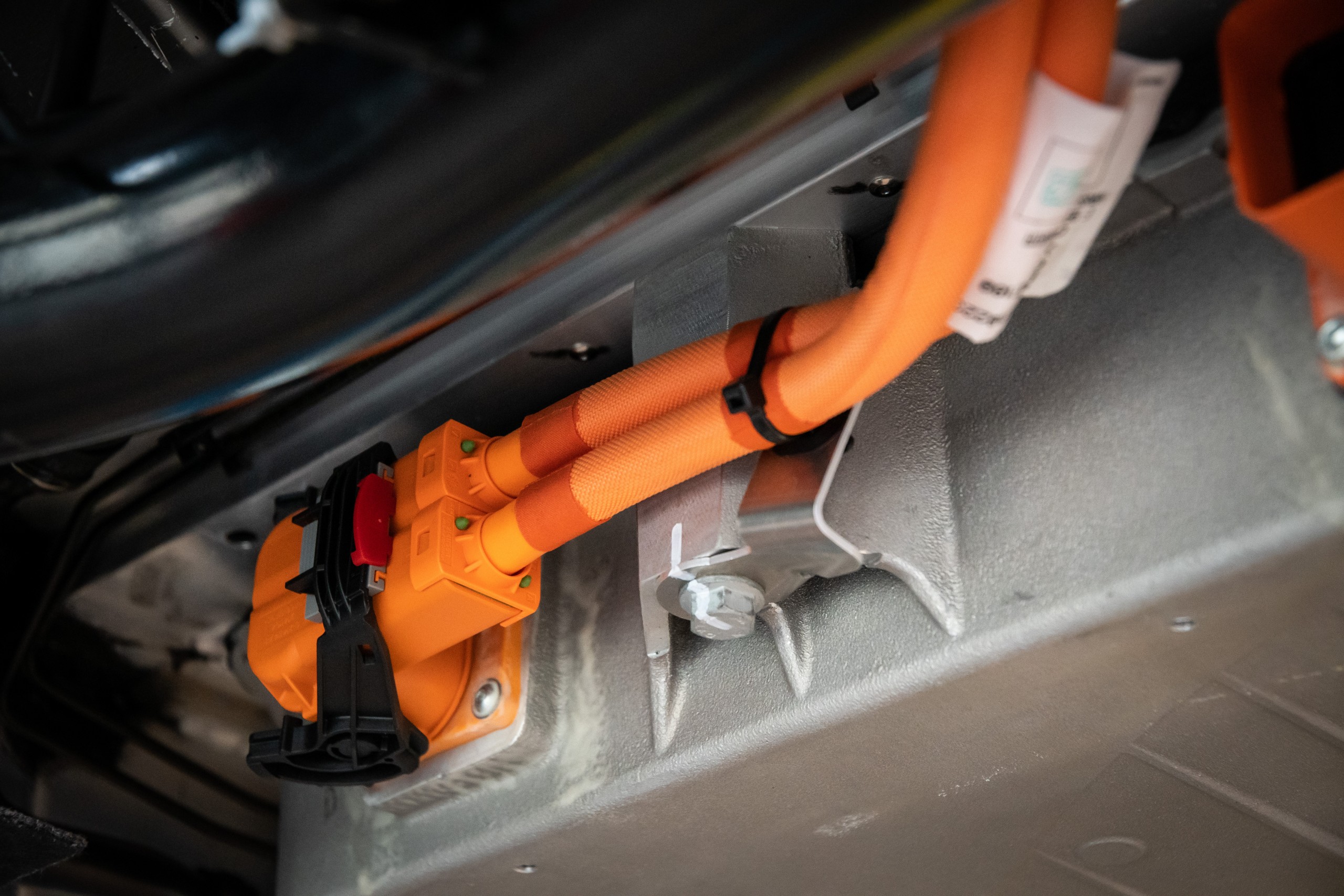
Since the early 2000s, the Allianz Center for Technology has been analyzing the repairability and insurance aspects of electric and hybrid vehicles, collectively referred to as high-voltage vehicles.
Specific research fields of the AZT are
- Deformation behavior
- Protection of expensive components (e. g. high voltage battery, power electronics, cables) in the event of accidents
- Crash management ⇔ Lightweight construction
- Influence of new construction methods, e. g. CFRP, large cast part
- Repairability
- Safety regulations (qualification, equipment)
- Body shop processes and guidelines
- Possible additional costs in bodyshops and their reduction
- Battery repair, particularly with regard to the sustainability of e-mobility
- Statistical observation of the claims process
- Special damage characteristics and cost drivers
- Fire risk and other characteristics that are publicly perceived as critical
- Special topics, e. g. marten damage, damage caused by animals
- Work and communication in associations and committees
- International working groups (RCAR) to address recognized specific challenges and design standards
- Participation in the GDV (German Insurance Association), VDA (German Association of the Automotive Industry), VDIK (Association of International Motor Vehicle Manufacturers e.V.) committees for guidelines (e. g. quarantine areas) and regulations
- Direct advice to manufacturers in the event of identified need for improvement, e. g. damage to the underside of the battery

In addition to crash tests and repair tests with high-voltage vehicles, tests have also been carried out on the effect of temperature on the high-voltage battery in the context of painting, for example, and extensive statistical surveys on the occurrence of damage. As new vehicle manufacturers are establishing themselves in the field of electromobility, who lack essential empirical values, especially for insurance classification, the AZT also offers consulting cooperation.
Current publications on this topic can be found in the download area in the "E-mobility" section.
External video
This video is loaded in a YouTube player. This means that Google collects information about your use of the information provided and uses it for analysis and marketing purposes. However, if you would still like to view this video, you must change the cookie settings.
Open cookie settings
Use of vehicle data for accident investigation
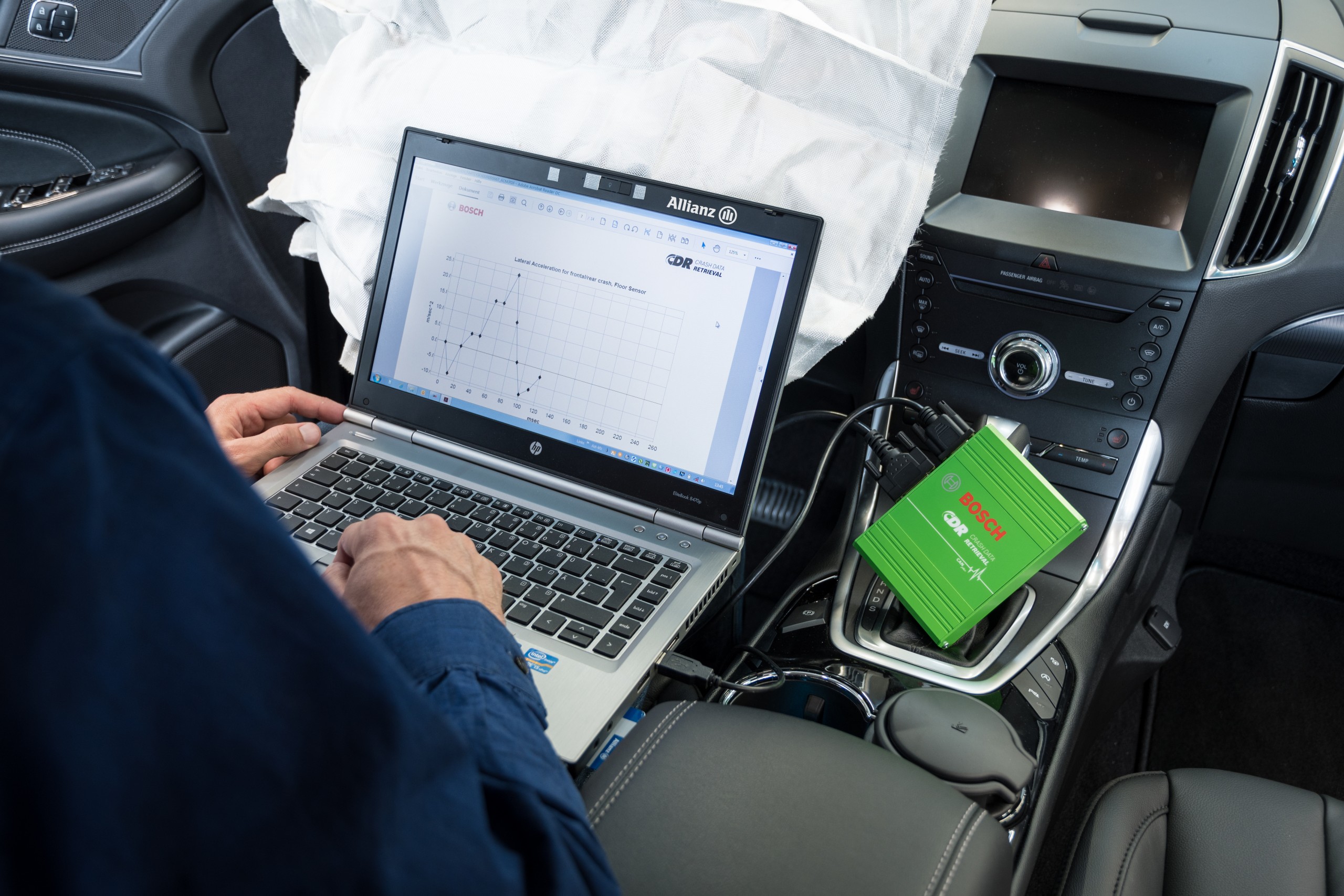
Modern vehicles are connected with their environment, compatible with individual apps, equipped with an increasing number of mandatory assistance systems that have a noticeable impact on driving and can be updated with software overnight. This justifiably raises the question of what actually happens to the data generated and stored in the vehicle and how it can be used in a value-adding, but also misuse-free, safe and fair way. However, the interests of vehicle users, the vehicle industry, insurance companies, service providers and research differ widely, making it difficult for legislators to find suitable regulations. The EU Data Act, which has already been adopted, aims to do just that, but is not yet specific enough for vehicle data.
Allianz is directly affected by this, as event data stored in the vehicle in the event of motor claims, such as accidents, breakdowns or theft, is required for claims settlement. A survey conducted by Allianz in 2023* showed that two thirds of all respondents agree to the use of data stored in the vehicle to clarify the fault for an accident and that every party involved must have the right to receive the necessary data. Incident data from the vehicle can not only be used to reconstruct courses of accidents, check the plausibility of claims and clarify liability issues, but also to speed up the entire claims process from notification to settlement, making it more digital and customer-friendly.
The entire claims management process can thus be optimized to meet the needs of customers if they are not only asked for their personal feedback after a claim has been completed, but if all the data collected on a claim can be used to improve the system and processes. With structured data in great detail, differentiated cost analyses in claims management are possible so that cost drivers and trends can be identified at an early stage. Allianz is therefore committed to ensuring that vehicle owners have full control over their data and can decide who may use the data from their vehicle for certain purposes and when. To ensure this, a regulated and secure marketplace for data exchange, transparency regarding data availability and fair prices for the provision of data by vehicle manufacturers are absolutely essential.
The Allianz Center for Technology contributes the technical basis for appropriate data parameters, event detection by vehicle systems, data security and non-discriminatory access to this data to the relevant committees, working groups and research projects. The Allianz´ position on data and victim protection and the safety of automated driving functions is a high priority and is taken into account in all discussions.
Specifically, AZT is working on the following topics:
- Remote or analog readout, analysis and interpretation of vehicle data
- Test fields for various readout tools for error memory, event memory or the state of health of the high-voltage battery
- Contributing to the design of digital claims processes, e. g. for automated accident and claims reporting
- V2X communication for greater road safety
- Telematics applications for more specific and individualized risk assessment
The 11th Allianz Motorday 2023 dealt explicitly and not for the first time with the topic of vehicle data and Allianz regularly presents its positions to the press.
You can find more details under the following links:
- Allianz Position Paper on Accident Data from Connected and Automated Vehicles
- 7th Allianz Motorday press release (in german language only)
- poster of the AHEAD working group as PDF (in german language only)
- Allianz survey: High approval for data use for accident investigation | Allianz (in german language only)
- Vehicle data can become a turbo for the European digital economy | Allianz (in german language only)
* Representative online survey by Allianz of 5200 drivers in 2023 in Germany (N=1200), Italy, France, Great Britain and Spain (N=1000 each) by the Allianz market research institute DrivenBy GmbH, the Allianz Center for Technology (AZT) and the market research company Ipsos. All results can be found in a 35-page report in German and English, which we will be happy to send you in electronic form.
Networks and IT security
In the course of digitalization, the global networking of systems and functions and the assessment of the risks this poses are increasingly coming to the fore - and this applies to the automotive industry as well. The new forms of technology in vehicles do not have to only function smoothly without any technical glitches, but they also have to be evaluated in terms of IT security. This gives rise to completely new challenges such as the forensic evidence of risks which arise through attacks and manipulation and may make the interfaces to the outside world insecure.
In this context, AZT is currently taking an in-depth look at two questions in particular:
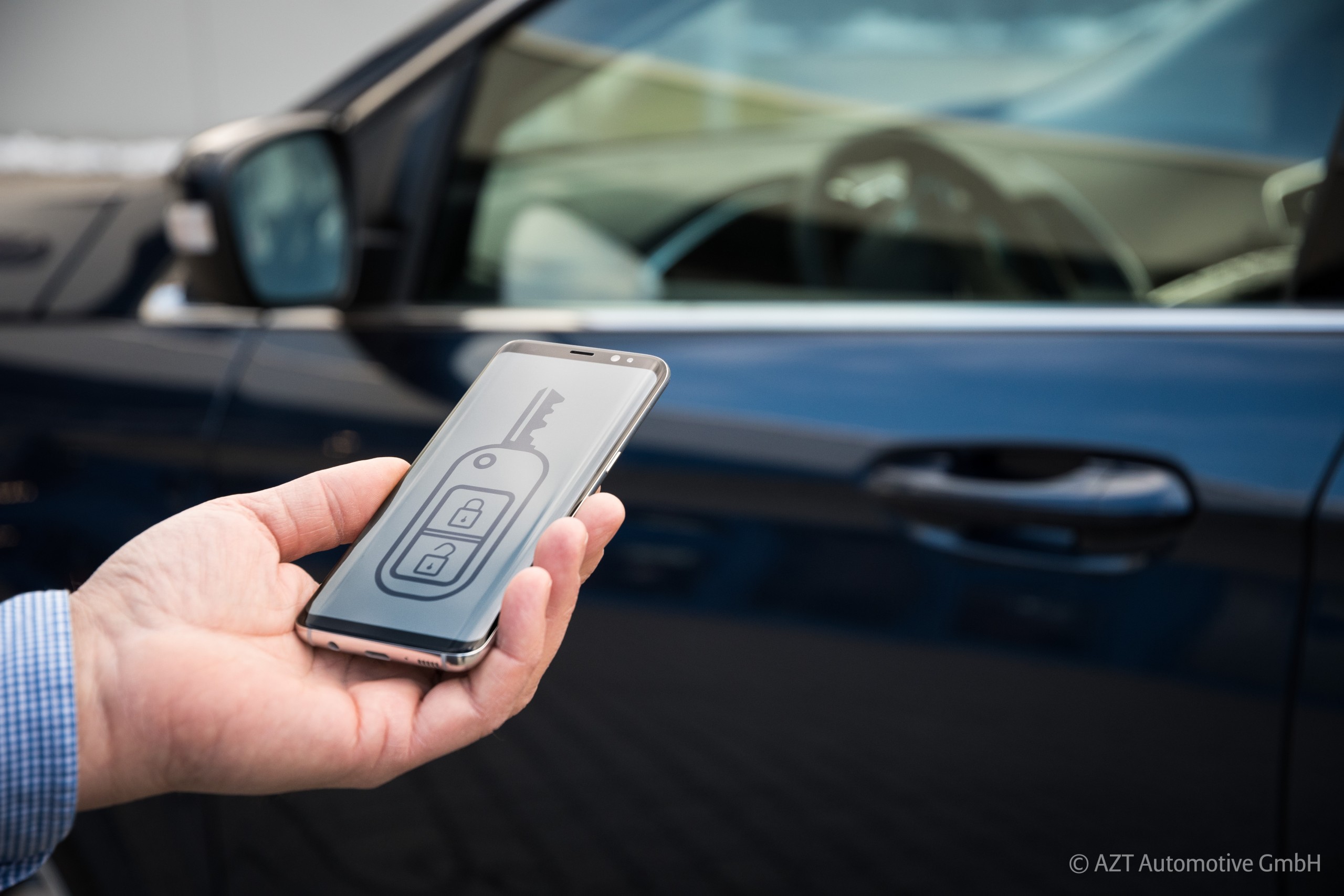
1. Analysis and risk assessment of newly networked functions, such as virtual vehicle keys.
AZT has analyzed the potential ecosystem "Virtual Vehicle Keys", addressed the existing and new potential risks and attack vectors, and formulated the requirements with regards to virtual vehicle keys.
The requirements are to serve as guidelines for the handling of networked and security-critical functions in a loss event from the insurer's perspective, and, at the same time, to assist the automotive manufacturers with the technical design of the system and its protection against misuse.
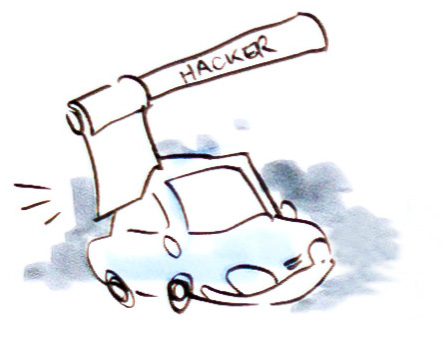
2. IT security in networked vehicles
Attacks on the wiring system of a networked vehicle may jeopardize the comfort, property and safety of the passengers, as well as threaten economic interests.
Within the scope of a long-term, interdisciplinary cooperation project with the private research institution InS³ headed by Prof. Dr. Rudolf G. Hackenberg, professor at Ostbayerische Technische Hochschule (OTH) in Regensburg, these digital risks are examined, and threats as well as attack methods analyzed in terms of IT security.
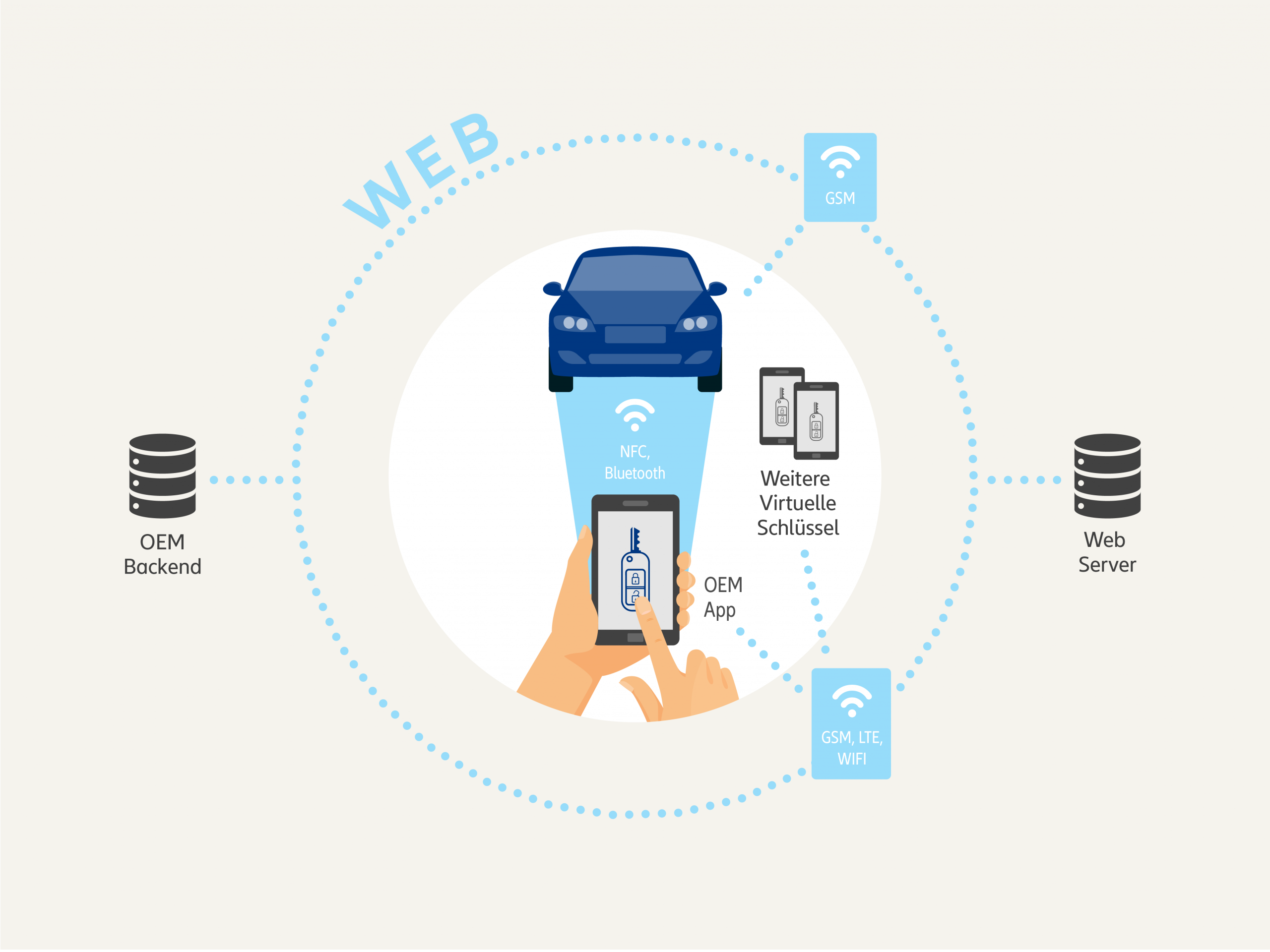
Ecosystem Virtual Vehicle Key
Driver assistance systems and automated driving
Driver assistance systems and automated driving are becoming increasingly important in modern transportation, significantly enhancing safety, efficiency, and convenience on our roads. These technologies are developing rapidly and have the potential to fundamentally change the way we get around.
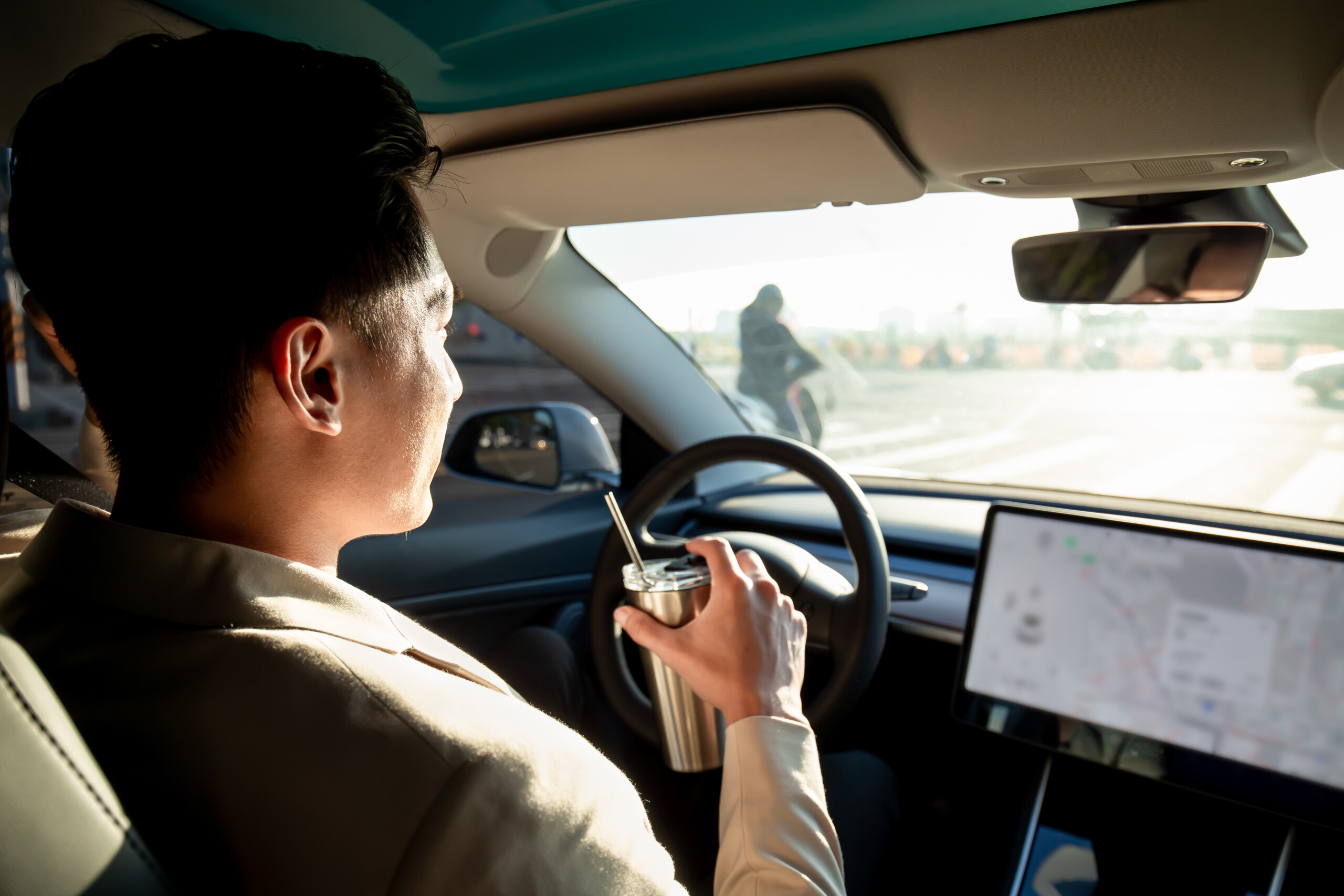
The integration of these technologies promises considerable benefits, including a reduction in the number of accidents, lower environmental impact through optimized driving styles, and increased mobility. However, there are also challenges that need to be overcome. These include legal and ethical issues, technical reliability, and public acceptance. In addition, considerable investment in infrastructure and the development of new standards are required.
Increasing automation in road traffic also requires insurance companies to proactively adapt and innovate in order to take advantage of the opportunities and manage the risks associated with this technological development. We at AZT are therefore addressing the following topics:
- Risk assessment and premium calculation: With the introduction of driver assistance systems and autonomous vehicles, the risk profile in road traffic is changing. Insurers need to adapt their risk assessment models to take into account the impact of these technologies on accident frequency and severity. This can be complex , as there may be fewer accidents overall, but the repairs could be more expensive due to the advanced technology involved.
- Liability issues: Automation raises new questions about liability. In the event of an accident involving an autonomous vehicle, the question arises as to whether the driver, the vehicle manufacturer, the software developer or, in the case of Level 4 autonomous driving, the teleoperator is liable. Insurers need to develop new insurance cover concepts that do justice to these complex scenarios.
- Data management and data protection: Automated vehicles generate large amounts of data that can be valuable for accident reconstruction and risk assessment. Insurers need to find ways to use this data efficiently while complying with data protection regulations. Securely handling sensitive data is crucial for gaining and maintaining customer trust. At the same time, this data is essential for objectively clarifying the facts and ensuring a fair settlement of the claim.
- Product development: Insurance products must be further developed to meet the needs of customers in the age of automated driving. This could include specialized policies for autonomous vehicles or new services such as insuring mobility instead of the individual car.
- Regulatory adjustments: The insurance industry must adapt to new legal and regulatory frameworks that accompany the introduction of automated vehicles. This may involve changes to the requirements for insurance coverage and obligations.
- Market change: Automation could lead to shifts within the traditional car insurance market as fewer accidents and associated claims occur. At the same time, the demand for individual vehicle insurance may decrease due to increased availability of automated mobility services and demographic changes. Insurers must explore new business areas and develop innovative solutions in order to remain competitive.
For over a decade, AZT's accident research has been analyzing potential effects as part of several research projects (e.g. AKTIV, TRACE, euroFOT). This research has significantly contributed to the integration of effective driver assistance systems into the calculation of insurance premiums in several countries (e.g. the automatic emergency braking system AEB).
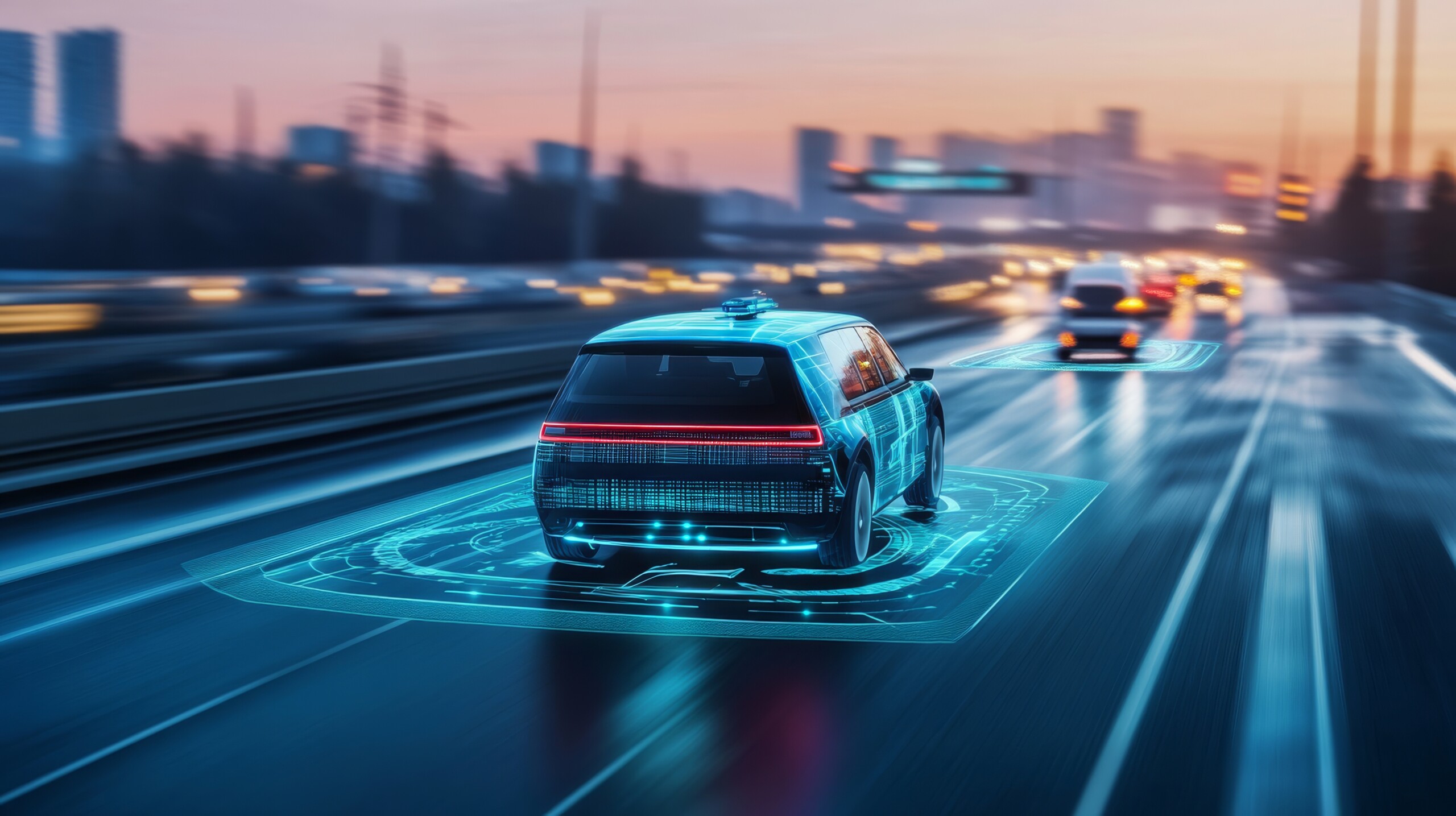
AZT's impact potential assessment is based on the motor vehicle liability and comprehensive insurance claims reported to Allianz Versicherung on a regular basis. Using several claims databases, the AZT continuously evaluates driver assistance systems at the navigation, guidance and stabilization levels, both prospectively and retrospectively. This evaluation ranges from minor property damage to the most serious personal injuries.
AZT has also set itself the task of testing the effectiveness of emergency braking systems under realistic conditions. In a controlled test scenario, a test driver approaches an obstacle and the automatic intervention of the emergency brake assist is documented. A Soft Car 360° was used for the tests at the AZT, similar to those conducted in Euro NCAP assessments.. In addition, AZT has high-precision measurement technology for determining speed, position and distance (using differential GPS). This setup allows for tests to be conducted with repeatable accuracy at both higher speeds and at parking and maneuvering speeds.
External video
This video is loaded in a YouTube player. This means that Google collects information about your use of the information provided and uses it for analysis and marketing purposes. However, if you would still like to view this video, you must change the cookie settings.
Open cookie settings
Example of an AEB test at 30 km/h
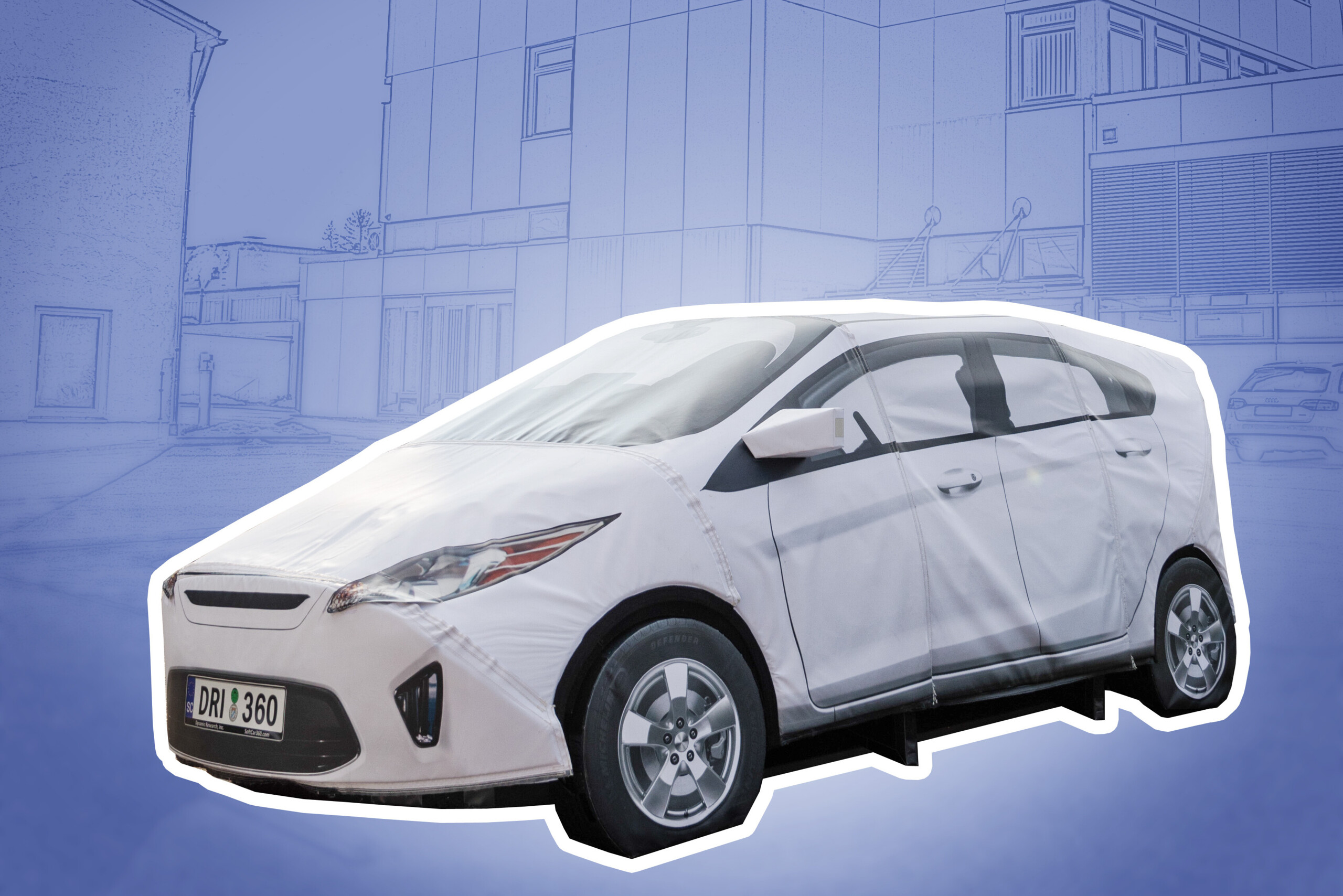-3382x2256-2560x1708.jpg)
Soft Car 360°
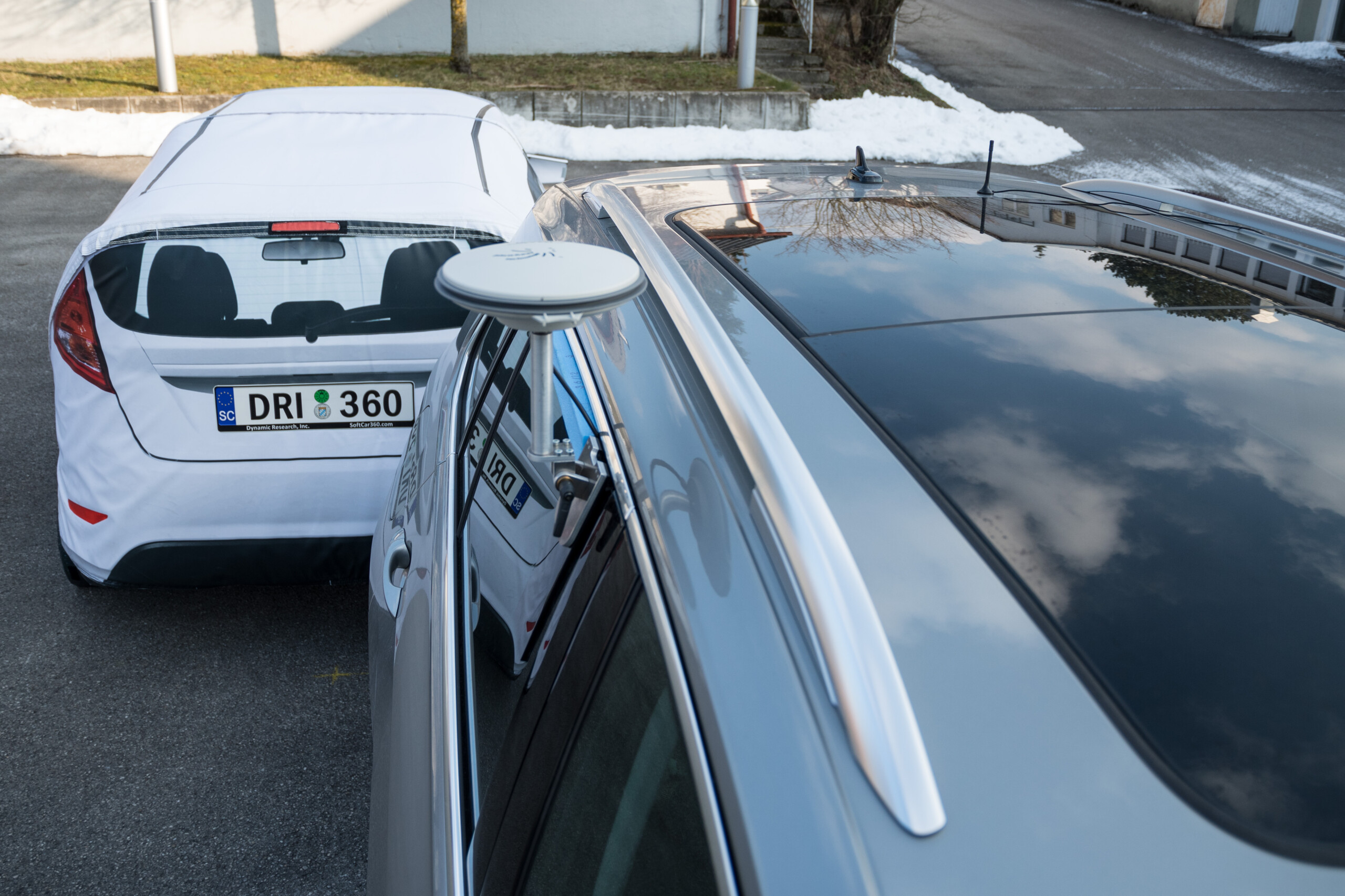
Differential GPS antenna
For several decades, AZT has been actively engaged in research and development effortsaimed at enhancing road safety. In cooperation with leading vehicle manufacturers, renowned university institutes and key associations, AZT focuses on scientific projects aimed at ensuring the safety of automated and autonomous driving. Our goal is to enhance technological standards and maximize safety for all road users through innovative approaches and well-founded analyses. By sharing knowledge and expertise, we are helping to make the future of driving safer and more efficient.
Repair research
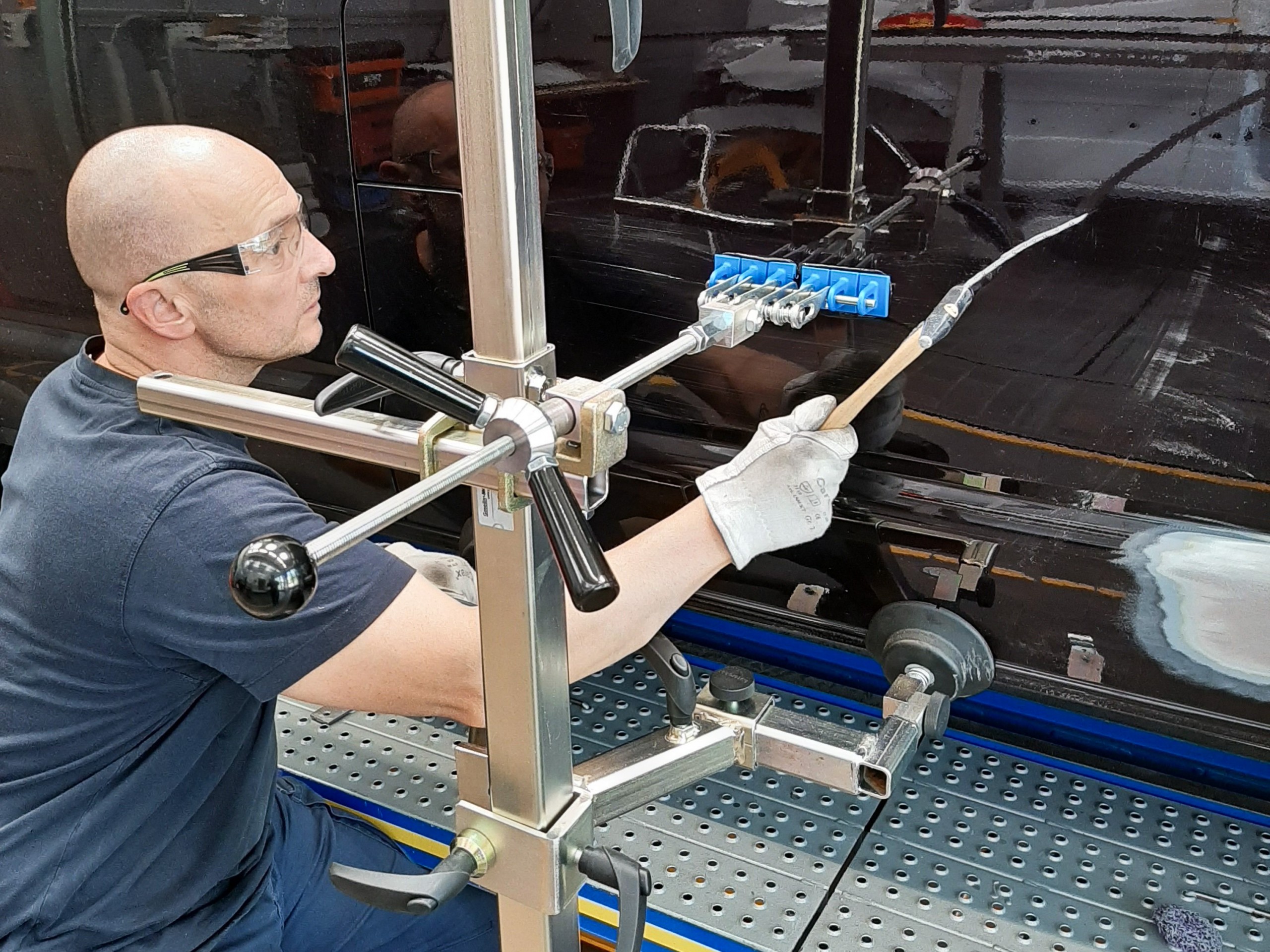
Repair costs constitute a large portion of claims costs in motor insurance. AZT investigates and supervises new developments in paint and bodywork repair with the aim of promoting professional and cost-effective repair solutions.
By repairing real-life vehicle damage, trained REFA experts (www.refa.de) analyze the repair times and material consumption according to established industry standards. Time studies are carried out both at the AZT and at independent external repair shops. The purpose of these tests is to determine the basis for calculating repair costs correctly.
The Allianz Center for Technology maintains a range of calculation systems and aids:
AZT paint calculation system to determine the cost of painting
AZT caravan and motor caravan calculation system
Calculation aid for panel beating, plastic repairs and spot repairs
These are available to users via the calculation software offered by many providers in the market. Among others, we cooperate with Audatex, Autovista International AG, DAT and CAB. In particular, the calculation systems are used by experts, repair shops, Allianz companies and other insurers.
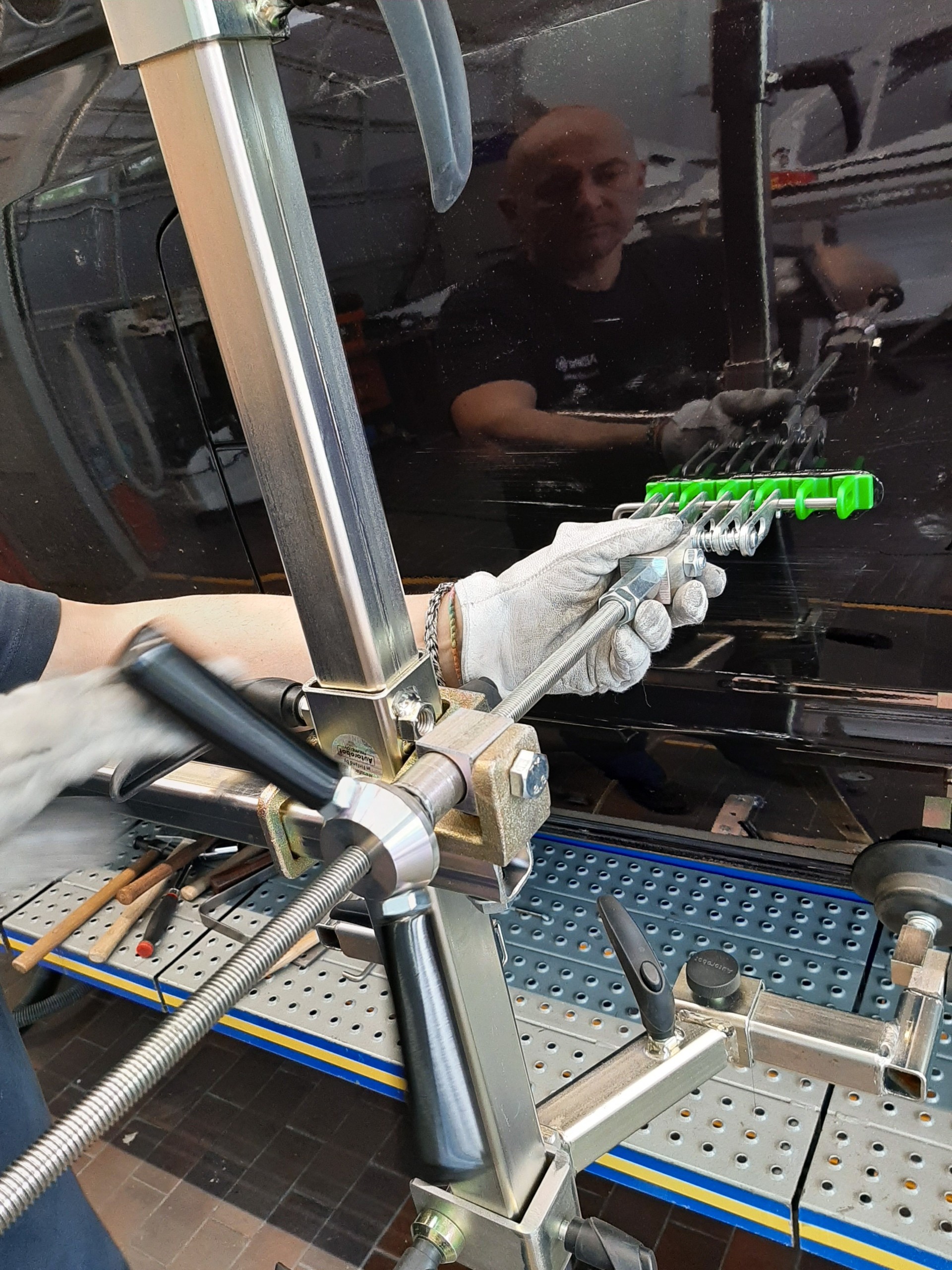
In addition, interested parties also have the option of subscribing to the AZT "Technische Mitteilungen", which summarize the results from research work and the collaboration with automobile and paint manufacturers and is published in the form of a loose leaf collection (AZT Technische Mitteilungen).
In addition, a catalog of vehicle repair studies involving repair work which is calculated according to the time required (REFA) and then compared to the calculation based on the panel-beating formula provides assistance when selecting a professional and economical method of repair. These repair examples are also available as part of the subscription.
Apart from the integration of the AZT information in the Audatex calculation system, the data is also offered on the information platform Repair-Pedia.
The AZT paint calculation system
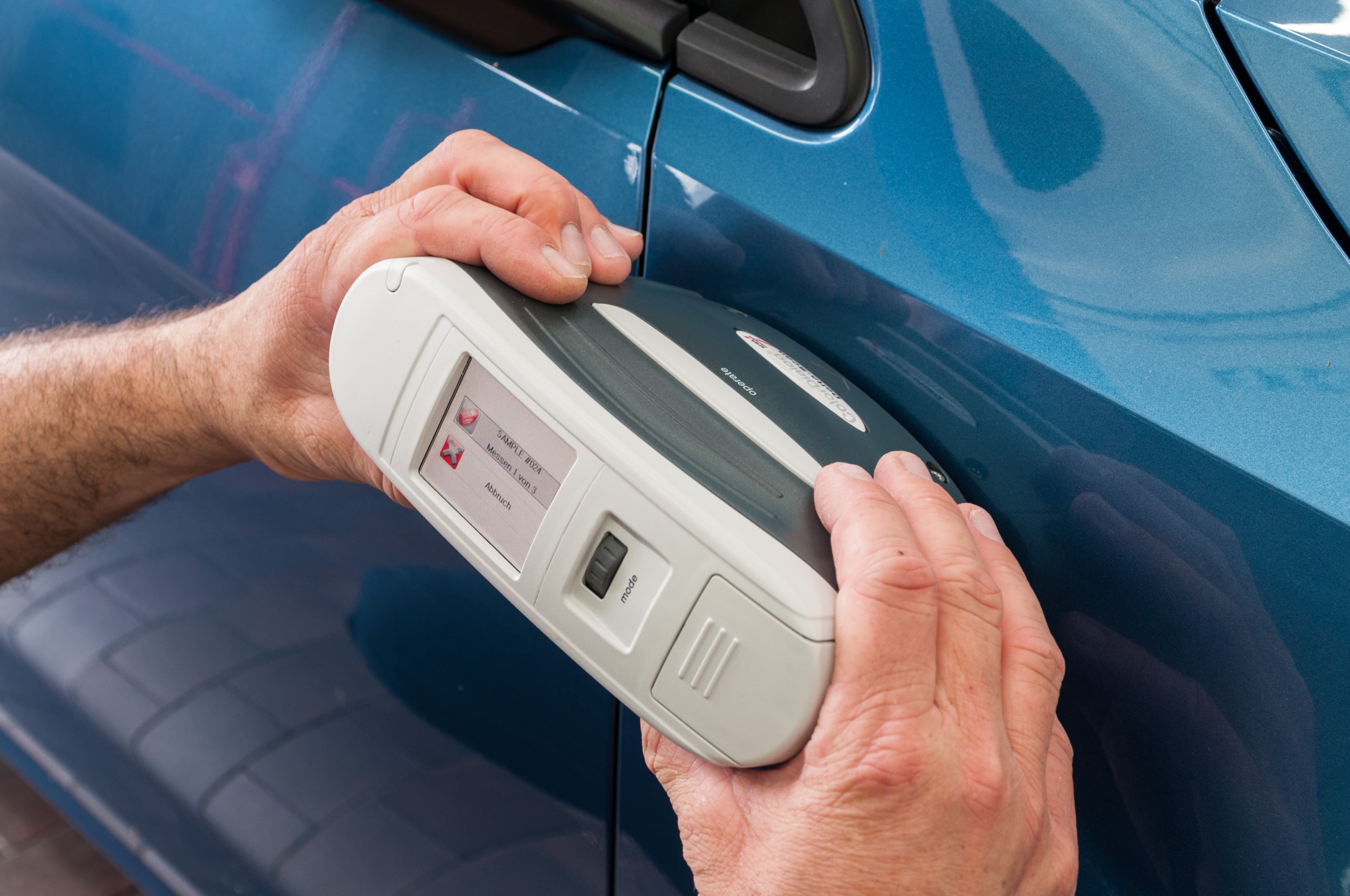
Since its introduction in 1977, the AZT paint calculation system has established itself as the leading, manufacturer-independent international standard for the calculation of paintwork, and is used in more than 35 countries all over the world - and this trend is growing.
The materials and methods currently used for repair paint jobs form the basis of the paint calculation system. New vehicle models are regularly added to the system, and values are updated frequently. New materials and methods are examined, and are taken into account in accordance with their market importance.
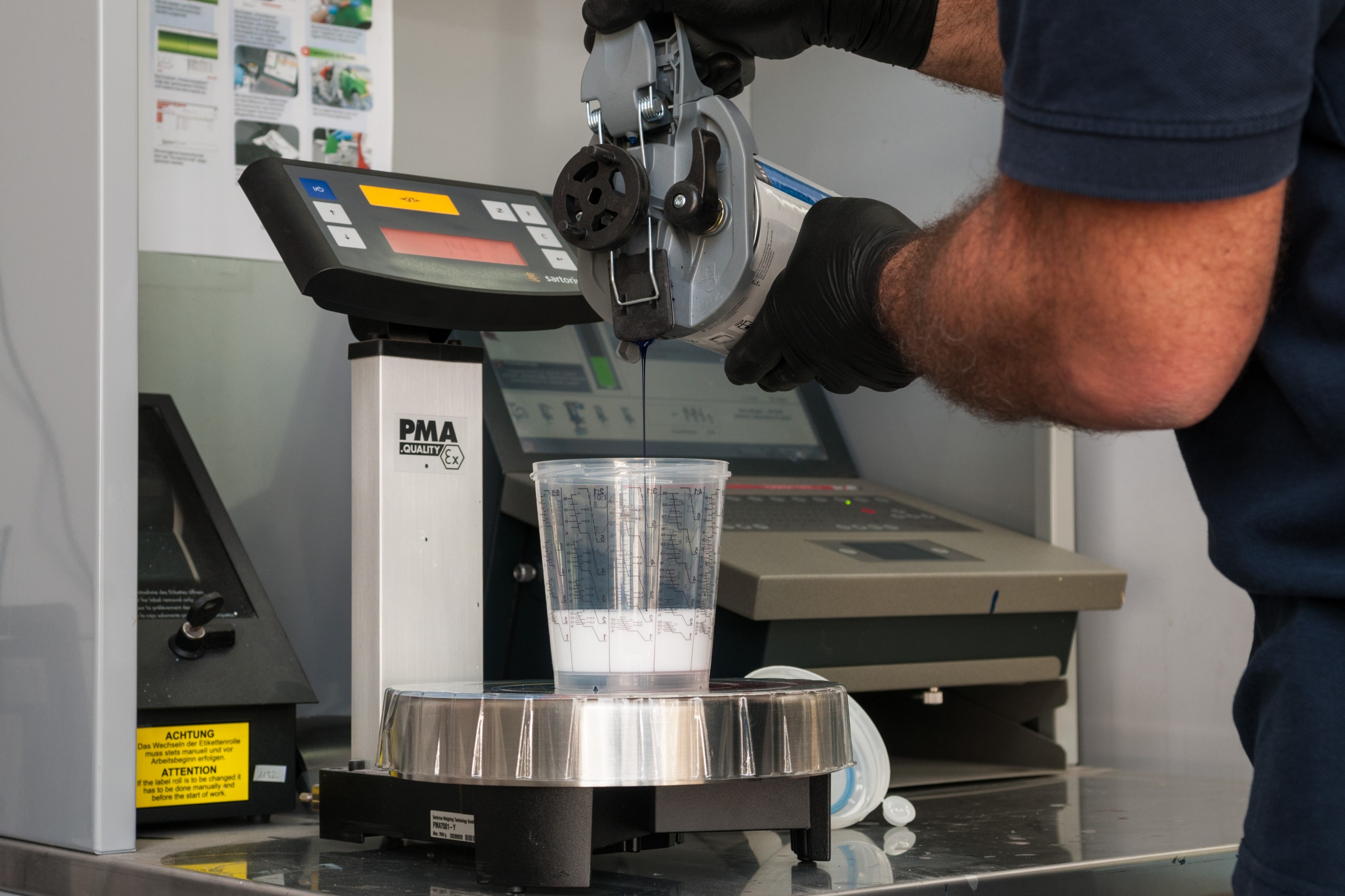
The users of this system receive:
- all necessary information relating to processing time and expenditure, quickly and simply
- calculation values for passenger vehicles, off-road vehicles and transport vehicles included in the system
- the amount of time needed to complete the paint repair, in hours
- the current paint costs for the repair, in the respective national currency
The AZT paint calculation system covers over 4,000 models. Annually, more than 10 million paint jobs are calculated worldwide with the aid of the system.
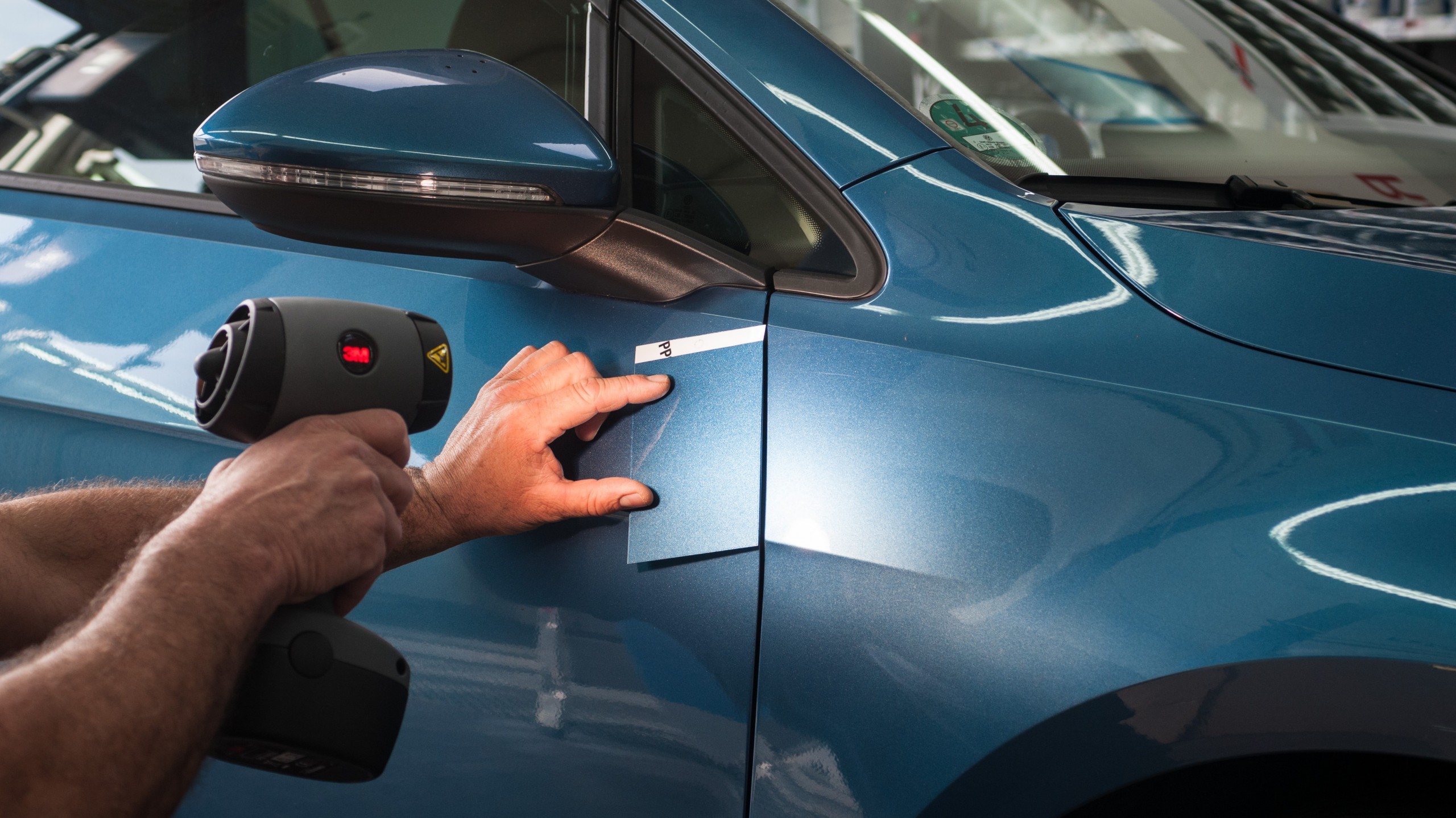
Crash tests for improved repairability
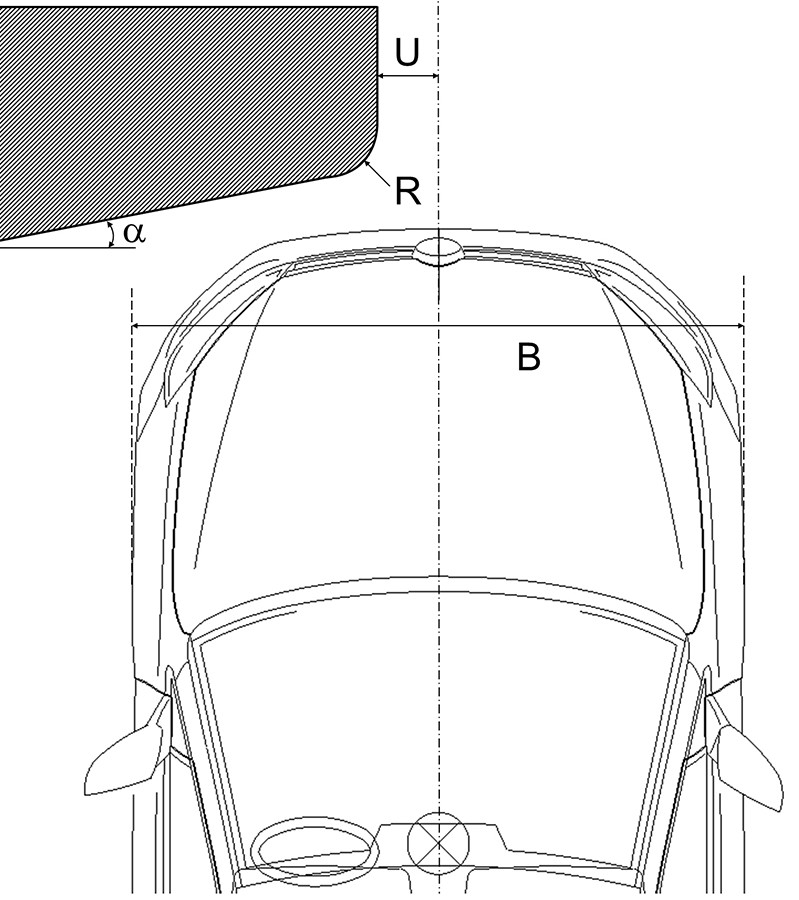
Since 1982, the crash repair test developed in the Allianz Center for Technology (AZT) has been considered the criterion for the repairability of vehicles following smaller accidents. In Germany, an independent trustee derives the vehicle type class for fully comprehensive insurance from the results of these tests; as such, they have a direct impact on the insurance classification of cars which are newly introduced onto the market.
Today, the crash repair test is represented by an international working group (www.rcar.org) and has been standardized throughout the world for the front and rear. As such, these tests are also similarly used in other countries around the globe for the insurance classification.
We can run these tests on our own crash track.
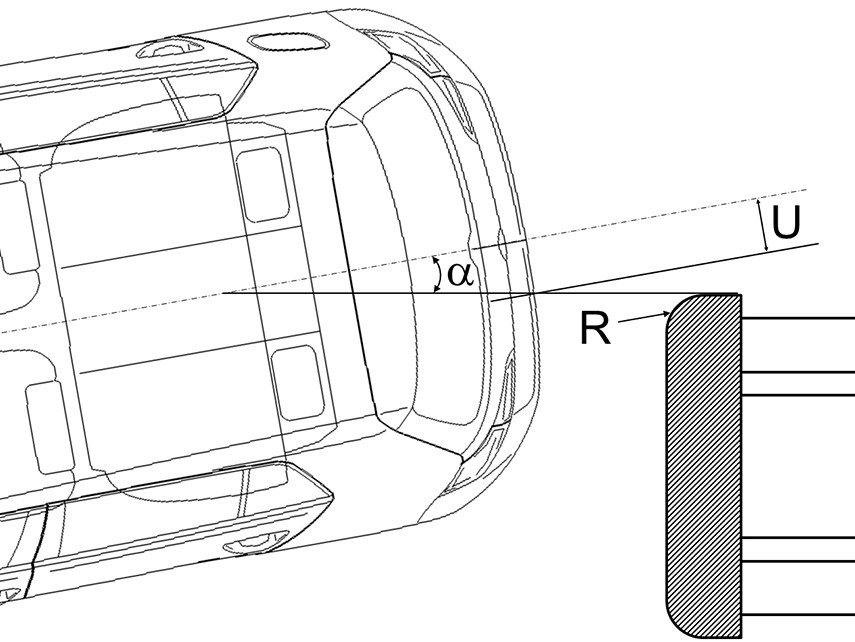
In a frontal crash, the vehicle hits a hard barrier at a speed of 15 km/h; the barrier covers 40 % of the front of the vehicle and stands at an angle of 10 degrees. The bumper and the components behind it on one side have to dissipate the energy. Similarly, in a rear-end crash, a 1,400 kg barrier is driven against the stationary car.
Since a stationary car is - unlike the barrier - deformable, the crash repair test corresponds to an accident involving a real vehicle travelling at approximately 25 km/h collision speed.
External video
This video is loaded in a YouTube player. This means that Google collects information about your use of the information provided and uses it for analysis and marketing purposes. However, if you would still like to view this video, you must change the cookie settings.
Open cookie settings
Both testing methods are aimed at covering typical, everyday accidents, and should hence not be confused with tests conducted to assess occupants' safety (ECE, NCAP), which have to address accidents of significantly higher, albeit considerably less frequent, degrees of accident severity, and are hence primarily focused on occupants' safety.
However, the positive results achieved in the laboratory have to also be reflected in good energy absorption demonstrated by the vehicles in a real accident. This is possible only if bumpers interact without sliding against each other. In this conjunction, an international working group (rcar.org), headed by the Allianz Center for Technology, hence developed a test which is aimed at ensuring the geometrical compatibility of various vehicles, and, in the experiment, also examines the interaction of the bumpers until the vehicles have come to a standstill.
This bumper test was defined in 2006, and has been binding since 2010 for the type classification of all vehicles newly introduced to the market. It is evaluated by an independent trustee in the classification process - in addition to the crash repair test.
For the bumper test, the minimum requirements for the bumper dimensions are first examined. If these requirements are satisfied, a test drive may be conducted. During the bumper test, the vehicle collides into the middle of a hard barrier while travelling at 10 km/h. The bumper should not slide over or under the barrier, and the components behind it, such as the expensive cooler or the rear panel, should not undergo any damage.
External video
This video is loaded in a YouTube player. This means that Google collects information about your use of the information provided and uses it for analysis and marketing purposes. However, if you would still like to view this video, you must change the cookie settings.
Open cookie settings
The bumper test has been established as a standard throughout the world (rcar.org). Unlike the more spectacular experiments for the evaluation of occupants' safety (ECE, NCAP), this test addresses more frequent, everyday accidents, and is aimed at reducing costs.

"In developing crash test standards, the Allianz Center for Technology has a significant influence on the crash performance of modern vehicles at low and medium collision speeds. This helps avoid unnecessary repair costs. Ultimately, this reduces the vehicles' running costs."
Dr. Christoph Lauterwasser, former Managing Director AZT Automotive GmbH